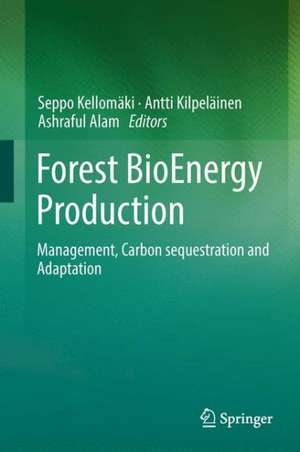Forest BioEnergy Production: Management, Carbon sequestration and Adaptation
Editat de Seppo Kellomäki, Antti Kilpeläinen, Ashraful Alamen Limba Engleză Hardback – 12 sep 2013
This book summarizes recent experiences on how to manage forest land to produce woody biomass for energy use and what are the potentials to mitigate climate change by substituting fossil fuels in energy production. In this context, the book addresses how management can affect the supply of energy biomass using short-rotation forestry and the conventional forestry applying long rotations. Furthermore, the book outlines the close interaction between the ecological systems and industrial systems, which controls the carbon cycle between the atmosphere and biosphere. In this context, sustainable forest management is a key to understand and control indirect carbon emissions due to the utilization of forest biomass (e.g. from management, harvesting and logistics, and ecosystem processes), which are often omitted in assessing the carbon neutrality of energy systems based on forest biomass. The focus in this book is on forests and forestry in the boreal and temperate zones, particularly in Northern Europe, where the woody biomass is widely used in the energy industry for producing energy.
Toate formatele și edițiile
| Toate formatele și edițiile | Preț | Express |
|---|---|---|
| Paperback (1) | 943.88 lei 6-8 săpt. | |
| Springer – 22 aug 2016 | 943.88 lei 6-8 săpt. | |
| Hardback (1) | 948.16 lei 6-8 săpt. | |
| Springer – 12 sep 2013 | 948.16 lei 6-8 săpt. |
Preț: 948.16 lei
Preț vechi: 1156.29 lei
-18% Nou
Puncte Express: 1422
Preț estimativ în valută:
181.43€ • 189.43$ • 150.16£
181.43€ • 189.43$ • 150.16£
Carte tipărită la comandă
Livrare economică 04-18 aprilie
Preluare comenzi: 021 569.72.76
Specificații
ISBN-13: 9781461483908
ISBN-10: 1461483905
Pagini: 150
Ilustrații: XI, 268 p. 99 illus., 26 illus. in color.
Dimensiuni: 155 x 235 x 22 mm
Greutate: 0.52 kg
Ediția:2013
Editura: Springer
Colecția Springer
Locul publicării:New York, NY, United States
ISBN-10: 1461483905
Pagini: 150
Ilustrații: XI, 268 p. 99 illus., 26 illus. in color.
Dimensiuni: 155 x 235 x 22 mm
Greutate: 0.52 kg
Ediția:2013
Editura: Springer
Colecția Springer
Locul publicării:New York, NY, United States
Public țintă
ResearchCuprins
Chapter 1. Introduction.- PART I: Forest Management for Bioenergy Production.- Chapter 2. Tree species, genetics and regeneration for bioenergy feedstock in northern Europe.- Chapter 3. Short-rotation forestry for supplying biomass for energy production.- Chapter 4. Integrated production of timber and energy biomass in forestry.- Chapter 5. Nutrient management for sustainable production of energy biomass in boreal forests.- Chapter 6. Fertilization in boreal and temperate forests and the potential for biomass production.- Chapter 7. Integration of management measures for bioenergy production from spatial and temporal perspectives in a forest region – the case of Finland.- PART II: Mitigation and Carbon Sequestration.- Chapter 8. Effects of bioenergy production on carbon sequestration in forest ecosystems.- Chapter 9. Stump harvesting, bioenergy feedstock and sequestration of carbon in soil.- Chapter 10. Life cycle carbon assessment of bioenergy production.- Chapter 11. Time dynamics and radiative forcing of forest bioenergy systems.- PART III: Adaptation.- Chapter 12. Climate change and forest management: implications for energy biomass production in boreal forest ecosystems.- Chapter 13. Risk and uncertainty in adaptive forest management under climate change.- Chapter 14. Economic competitiveness of forest biomass energy.- PART IV: Future Direction/ Conclusions.- Chapter 15. Conclusions.- Annex.
Textul de pe ultima copertă
For thousands of years, forest biomass or wood has been among the main energy sources of humans around the world. Since the industrial revolution, fossil fuels have replaced wood and become the dominant source of energy. The use of fossil fuels has the disadvantage of increasing atmospheric concentrations of greenhouse gases (GHGs), especially carbon dioxide (CO2), with the consequent warming of global climate and changes in precipitation. In this context, the substitution of fossil fuels with renewable energy sources like forest biomass is among the ways to mitigate climate change.
This book summarizes recent experiences on how to manage forest land to produce woody biomass for energy use and what are the potentials to mitigate climate change by substituting fossil fuels in energy production. In this context, the book addresses how management can affect the supply of energy biomass using short-rotation forestry and the conventional forestry applying long rotations. Furthermore, the book outlines the close interaction between the ecological systems and industrial systems, which controls the carbon cycle between the atmosphere and biosphere. In this context, sustainable forest management is a key to understand and control indirect carbon emissions due to the utilization of forest biomass (e.g. from management, harvesting and logistics, and ecosystem processes), which are often omitted in assessing the carbon neutrality of energy systems based on forest biomass. The focus in this book is on forests and forestry in the boreal and temperate zones, particularly in Northern Europe, where the woody biomass is widely used in the energy industry for producing energy.
This book summarizes recent experiences on how to manage forest land to produce woody biomass for energy use and what are the potentials to mitigate climate change by substituting fossil fuels in energy production. In this context, the book addresses how management can affect the supply of energy biomass using short-rotation forestry and the conventional forestry applying long rotations. Furthermore, the book outlines the close interaction between the ecological systems and industrial systems, which controls the carbon cycle between the atmosphere and biosphere. In this context, sustainable forest management is a key to understand and control indirect carbon emissions due to the utilization of forest biomass (e.g. from management, harvesting and logistics, and ecosystem processes), which are often omitted in assessing the carbon neutrality of energy systems based on forest biomass. The focus in this book is on forests and forestry in the boreal and temperate zones, particularly in Northern Europe, where the woody biomass is widely used in the energy industry for producing energy.
Caracteristici
Addresses how management can affect the supply of energy biomass using short-rotation forestry and the conventional forestry applying long rotations Summarizes recent experiences on how to manage forest land to produce woody biomass for energy use and what are the potentials to mitigate climate change by substituting fossil fuels in energy production Outlines the close interaction between the ecological systems and industrial systems, which controls the carbon cycle between the atmosphere and biosphere Includes supplementary material: sn.pub/extras



